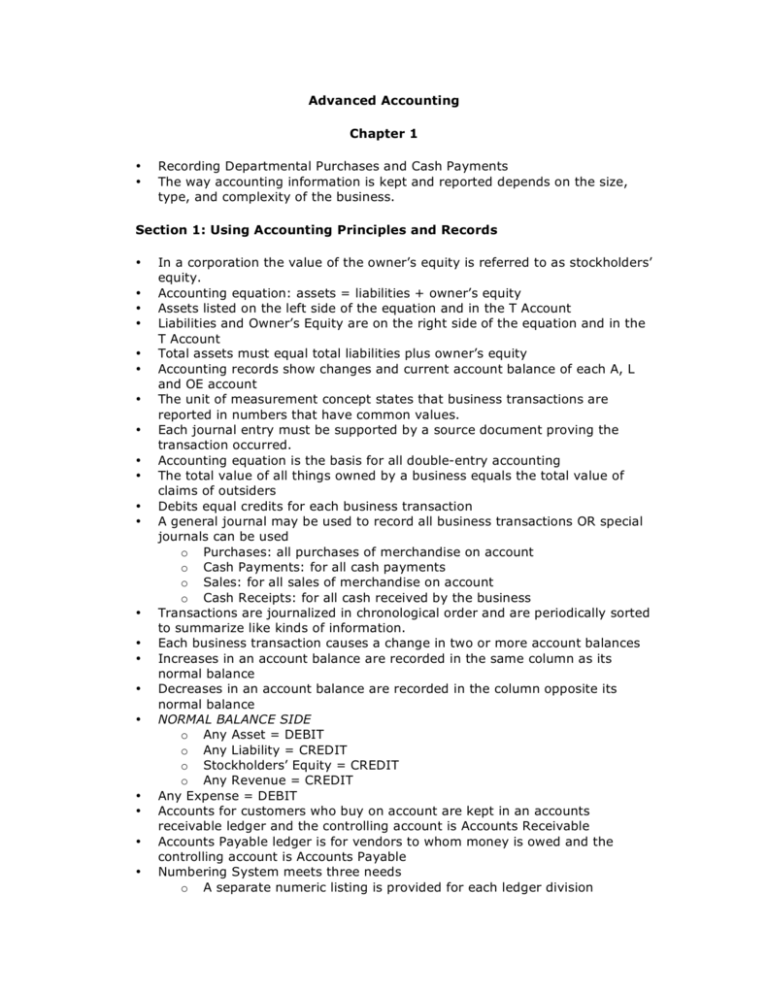Advanced Accounting Chapter 1 • Recording Departmental
advertisement

Advanced Accounting Chapter 1 • • Recording Departmental Purchases and Cash Payments The way accounting information is kept and reported depends on the size, type, and complexity of the business. Section 1: Using Accounting Principles and Records • • • • • • • • • • • • • • • • • • • • • In a corporation the value of the owner’s equity is referred to as stockholders’ equity. Accounting equation: assets = liabilities + owner’s equity Assets listed on the left side of the equation and in the T Account Liabilities and Owner’s Equity are on the right side of the equation and in the T Account Total assets must equal total liabilities plus owner’s equity Accounting records show changes and current account balance of each A, L and OE account The unit of measurement concept states that business transactions are reported in numbers that have common values. Each journal entry must be supported by a source document proving the transaction occurred. Accounting equation is the basis for all double-entry accounting The total value of all things owned by a business equals the total value of claims of outsiders Debits equal credits for each business transaction A general journal may be used to record all business transactions OR special journals can be used o Purchases: all purchases of merchandise on account o Cash Payments: for all cash payments o Sales: for all sales of merchandise on account o Cash Receipts: for all cash received by the business Transactions are journalized in chronological order and are periodically sorted to summarize like kinds of information. Each business transaction causes a change in two or more account balances Increases in an account balance are recorded in the same column as its normal balance Decreases in an account balance are recorded in the column opposite its normal balance NORMAL BALANCE SIDE o Any Asset = DEBIT o Any Liability = CREDIT o Stockholders’ Equity = CREDIT o Any Revenue = CREDIT Any Expense = DEBIT Accounts for customers who buy on account are kept in an accounts receivable ledger and the controlling account is Accounts Receivable Accounts Payable ledger is for vendors to whom money is owed and the controlling account is Accounts Payable Numbering System meets three needs o A separate numeric listing is provided for each ledger division A predesigned arrangement of numbers provided within each ledger division o Enough account number digits to allow addition of new accounts New accounts are assigned numbers using the unused middle number method – when no exact middle number use the next whole number The rule for rounding states that decimals less than 5 are rounded down, and decimals 5 or greater are rounded up. o • • Section 2: Journalizing and Posting Purchases and Purchases Returns • • • • • • • • • • • • • • • • • • • • Accounting information can determine the kinds of merchandise that produce the greatest or least profit With departmental accounting systems, gross profit is calculated for each department The general ledger must then include a number of separate department accounts (Purchases and Purchases Returns and Allowances) Merchandising Businesses may have two types of equipment – purchase for sale or to be used by the business Purchase invoices are used as the source document for all purchases on account All departmental purchases of merchandise on account are recorded in a purchases journal Each purchase invoice has a notation placed on it showing to which department the purchase applies Each department has a separate Purchases Debit column in the purchases journal Journalize a Purchase on Account o Date, vendor name, invoice number, amount recorded in Accounts Payable credit column, amount recorded in the correct department’s Purchases Debit column Individual amounts in the A/P Credit column of Purchases journal are posted to the vendor accounts – Purchases journal abbreviated P for Post. Ref. column Purchases of merchandise on account are recorded in the purchase journal Purchases of merchandise for cash are recorded in the cash payments journal The purchases journal is proved and ruled at the end of the month and the totals of the special columns are posted to the general ledger accounts. Merchandise may be returned to a vendor for a variety of reasons – the business will then need an adjustment to what they owe the vendor through a debit memo The customer sends the debit memo to let the vendor know the details of the purchases return or allowance An account showing deductions from a purchases account is a contra cost account Purchases returns and allowances (PRA) are kept in separate account and not deducted directly from the purchases account to help determine the proportion of the merchandise that was returned to the vendors Record PRA in the special journal Purchases Returns and Allowances PRA are posted like usual from the Accounts Payable Debit column – PR to indicate the special journal A PRA may be made after payment so the vendor account may have a debit balance instead of credit • • A contra balance is shown by enclosing the amount in ( ) in the account’s Balance column Prove, rule, and post the journal at the end of the month Section 3: Journalizing and Posting Cash Payments and Reconciling the Bank Statement • • • • • • • • • • • • • • • • Cash payments are usually made by check and are recorded in the Cash Payments Journal Seller’s can encourage early payment by allowing deductions from the invoice amount A purchases discount is usually stated as a percentage: 2/10, n/30 (2% discount if paid in the first 10 days, net (total) due in 30 days) A purchases discount reduces the net amount of cash paid for a purchase Purchases discounts are kept in separate accounts and not deducted from the purchases accounts Help the business see what proportion of purchases on account were allowed purchases discounts Journalize cash payment with purchases discount: debit AP, credit Cash and correct department’s Purchases Discounts If discount taken after PRA then have to deduct the PRA from the invoice amount and then figure the discount – refer to page 22 Journalize purchase of supplies and expenses like previously learned in the Cash Payments journal Petty Cash fund is replenished when it falls below a certain level or at the end of the month – write a check and cash it to replenish Should post often from the General Debit and Credit columns to the General Ledger and also the Accounts Payable Debit column At the end of the month prove, rule, and post the totals of the special columns – a check mark is ( ) is used to indicate General debit and credit column totals are not posted Bank statements are sent to customers to summarize accounts activities – need to reconcile the statement with the checkbook balance All bank charges listed on a bank statement are considered cash payments – use a memo to record the transaction in the CP journal Bank service charges = Miscellaneous Expense Credit Card Fees = Credit Card Fee Expense



